History of the
Quinault Reservation
by Dan Van Mechelen, Chairman
Quinault Allottees Association
1970 - 1986
To fully understand the present day Quinault Reservation, one must go back to the years ending 1855. In the early 1820's, white settlers, trappers, and traders began moving into western Washington. They came into areas that offered the most potential for homes and profit. This included farm lands, fir timber, and fishing areas. Settlers began to fan out in all directions from Forts Vancouver and Astoria into the lands of the Chinook, Cowlitz, and Chehalis Indians. Homesteads were staked out in the Chehalis River valley, along the north shore of the lower Columbia River, the Naselle and Willapa River valleys, along the Cowlitz River and eventually along all water systems in western Washington.
These early homesteads were followed by industry as whites began to exploit the resources of the area. Fir lumber and fish became known to the outside world and the race for riches was on. Lumber and fishing towns sprang up on and near the major waterways of the area. Towns such as Ilwaco, Chinook, Raymond, South Bend, Altoona, Aberdeen, Hoquiam, Longview, Kelso, Chehalis, Naselle, Cathlamet, Humptulips, and so on.
But what of the Indians of these areas? What of that race of people who had most graciously welcomed the first few whites to their homelands? Little did they know what was in store for them, for theirs was an entirely different way of life. They did not have to mark a section corner to show their ownership of an area. They wandered their own acknowledged lands and were respected by their Indian neighbors. If the berries were ripe, they could be found in the blueberry patches on the slopes of Mt. Adams, the cranberry bogs of the Long Beach peninsula and Grayland, on Salmonberry patches in the Chehalis River valley. If the salmon were running, the river bank was their home. The Cowlitz, Chehalis, Humptulips, Satsop, Quinault, Queets, Quileute, Grays, Naselle, and Columbia rivers treated them well.
They coexisted with their new white neighbors on equal terms at first, but gradually came to realize as the whites increased by leaps and bounds in numbers that this peaceful existence would never last. Many a wizened old Indian chief was saddened by the fact that the old way of life was threatened. The Indian could no longer roam from one area to another to exist, for he found himself encroaching on the self-established rights and privileges of the white settlers. The whites, in turn, resented he fact that Indians sometimes stood in the way of tremendous profit potential. Gradually, friction and resentment evolved among the two parties. Something had to be done as there was no stopping the influx of settlers to "God's Country." It was decided back in Washington, D.C., that the Indians of western Washington must cede or give up their land to the federal government at all costs.
The Beginning
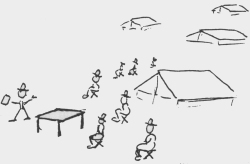
Governor Isaac Stevens was instructed to bring all Indian tribes and bands together to give up all title to the lands of western Washington and accept small pieces of land called reservations. Treaties were to be signed between the government and the Indians. The Indians did not know that they would lose their lands and be placed together with other tribes to live "in common" with their Indian neighbors. The date was February 20, 1855.
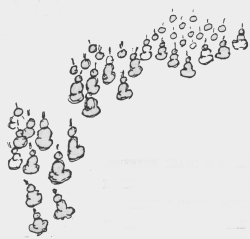 A treaty council was called by Governor Stevens, who was also superintendent of Indian Affairs of the Territory of Washington. The council was held on the banks of the Chehalis River near the present town of Cosmopolis. Stevens brought a treaty for the Indians to sign. It said that they would give up all title to almost all the coastal area of Washington. Stevens said that they would all be moved to a reservation that would be selected by the Great Father in Washington, D.C. The reservation was intended to be the Quinault Reservation as we know it today. This first treaty was never signed. As this story goes on, you will see why.
A treaty council was called by Governor Stevens, who was also superintendent of Indian Affairs of the Territory of Washington. The council was held on the banks of the Chehalis River near the present town of Cosmopolis. Stevens brought a treaty for the Indians to sign. It said that they would give up all title to almost all the coastal area of Washington. Stevens said that they would all be moved to a reservation that would be selected by the Great Father in Washington, D.C. The reservation was intended to be the Quinault Reservation as we know it today. This first treaty was never signed. As this story goes on, you will see why.
Stevens used army troops and scouts to bring Indian leaders to the treaty council. It is felt by many that the troops may have been used to intimidate the Indians so they would sign the treaty.
At the council, the Indians present were counted. There were 370 Indians present. Each band or village had also brought a bundle of sticks, with one stick for each Indian left at home. The sticks were counted. Altogether, there were 843 Indians, either at the council or left at home. There were 216 Upper Chehalis, 217 Lower Chehalis, 158 Quinault and Kwetsa (Queets), 112 Lower Chinook, and 140 Cowlitz. These tribes are repeatedly referred to as "the Fish-Eating Indians of western Washington." These were all the Indians left of those tribes from the thousands who had lived before the whites came. Hundreds of Indians had already died of white diseases.
At the council, Stevens found that the Quileute tribe had not been invited. They spoke a language that the scouts did not understand and they were passed over. Their numbers were about 300.
The proposed reservation was in the country of the Quileute, Hoh, Quinault, and Queets tribes. The area that was supposed to be ceded (or given up) by the Indians at this treaty council is shown below surrounded by the dotted line.
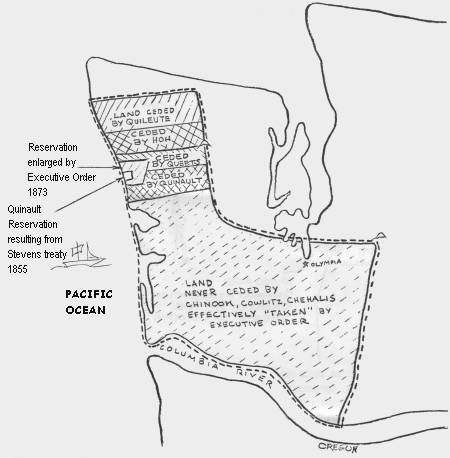 The Chinook, Chehalis, and Cowlitz Indians did not want to go onto a reservation to the north on the coast. They wanted small reservations where they lived, in the lands of their ancestors.
The Chinook, Chehalis, and Cowlitz Indians did not want to go onto a reservation to the north on the coast. They wanted small reservations where they lived, in the lands of their ancestors.
Why do you suppose the reservation was chosen where it is? At that time there was little homesteading north of the Humptulips River. A "white man rebellion" would have occurred if Stevens had asked some settlers to give up their homesteads for an Indian reservation. So the area chosen for a reservation had to suit white people.
The area chosen for a reservation was no good for farming and contained very little old growth fir. It was considered a "cedar swamp" with little economic value to whites.
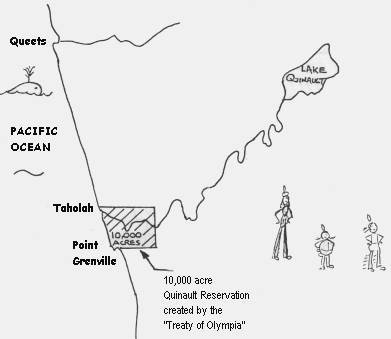
The Indian chiefs would not sign the treaty. After an antagonistic speech by Chehalis chief, Tulehuk, Governor Stevens in anger tore up the treaty and declared the council abandoned. Stevens' attempt to get the Indians to cede their lands resulted in failure and a rowdy break-up of the council after a week of futile negotiations. Stevens had failed miserably.
Governor Stevens made many mistakes. He chose a poor meeting place and had invited numerous tribes of widely differing cultures and languages. He was ignorant of the characteristics of the tribes and only vaguely knew their territorial locations. Many people today feel that Stevens looked down on Indian people and felt no compassion for them. Communication was by the pidgin English, Chinook jargon.
Later, a new treaty was drawn up and signed by the Quileutes and Quinaults. This second treaty established a 10,000 acre reservation around the village of Taholah. In exchange, the Quileutes, Queets, Hoh, and Quinaults gave up title to all the lands north of Gray's Harbor up to the land of the Makah. That treaty came to be known as the "Treaty of Olympia."
Both Stevens and the government realized that Stevens had failed his job. Title for all the rest of coastal Washington had not been taken from the Indians. In the Treaty of Olympia Stevens wrote, in Article VI, that the president could consolidate the Quileutes and Quinaults with other tribes and enlarge the reservation at a later time.
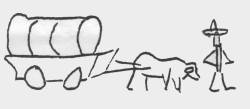 As time passed, settlers continued to pour in and homestead land that still belonged to the Indians who did not sign the treaty. The government still wanted to move all the other tribes to the treaty Quinault Reservation.
As time passed, settlers continued to pour in and homestead land that still belonged to the Indians who did not sign the treaty. The government still wanted to move all the other tribes to the treaty Quinault Reservation.
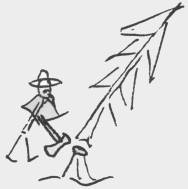 Ten thousand acres was far too little for all the "fish-eating" tribes of western Washington. This term "fish-eating" was destined to play a key role in the expansion of the reservation at a later date.
Ten thousand acres was far too little for all the "fish-eating" tribes of western Washington. This term "fish-eating" was destined to play a key role in the expansion of the reservation at a later date.
On October 1, 1872, R.H. Milroy, the local superintendent, reported that: The reservation was small, contained a very small amount of agricultural and pasture lands, had proved unattractive to the Indians, that the Chehalis, Chinook, and other tribes in southwestern Washington were "emphatically fish-eaters," and that all such tribes should be collected on a single reservation, including suitable fisheries. The superintendent also recommended that the existing reservation be greatly enlarged.
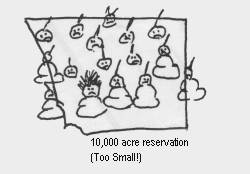 As a result of R.H. Milroy's recommendation, a much larger reservation was finally created on November 4, 1873, when an Executive Order by President U.S. Grant set aside the present day reservation which has been maintained to this day with the same boundaries, enclosing an area of about 200,000 acres. This new Quinault Reservation was created for all the "fish-eating" Indians of the Washington coast.
As a result of R.H. Milroy's recommendation, a much larger reservation was finally created on November 4, 1873, when an Executive Order by President U.S. Grant set aside the present day reservation which has been maintained to this day with the same boundaries, enclosing an area of about 200,000 acres. This new Quinault Reservation was created for all the "fish-eating" Indians of the Washington coast.
 In the course of time, and under the authority of the Executive Order, the residents and allotment holders of the Quinault Reservation came to include Indians of full or mixed ancestry from all tribes mentioned earlier, which is to say all tribes of coastal Washington and some from the interior, especially in the south.
In the course of time, and under the authority of the Executive Order, the residents and allotment holders of the Quinault Reservation came to include Indians of full or mixed ancestry from all tribes mentioned earlier, which is to say all tribes of coastal Washington and some from the interior, especially in the south.
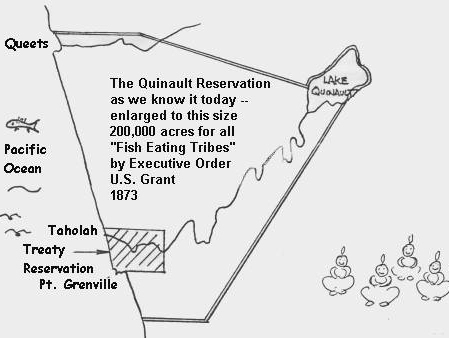
The Quinault Reservation is unique in that it is one of the few reservations on which individuals are issued allotments. Possession may be the result of an original grant by the United States, or through inheritance, will, purchase, or gift. The holding of the original allotments were by trust patent as a result of the "Dawes" or General Allotment Act of February 8, 1887. The first allotments on the Quinault Reservation were made in 1905, with the granting of applications for the meager agricultural acreage that was available. In 1909, the Commissioner of Indian Affairs reported that approval had been given to allotments of 80 acres of agricultural land, or 160 acres of grazing land, to 468 Indians. By 1912, practically all of the agricultural and grazing lands had been allotted, and Forestry Chief J.P. Kinney said that plans should be made for administering the forest lands for the general benefit of the reservation Indians. He was, however, strongly opposed to the allotting of forested lands.
By 1910, a controversy had developed over the rights of persons not aboriginally Quinault nor living on the reservation, as to whether they had the right to an allotment. This brought about an act of Congress on March 4, 1911 providing that "...Hoh, Quileute, Ozette, or other tribes in Washington who are affiliated with the Quinault and Quileute tribes in the treaty..." could receive allotments on the Quinault Reservation. The Act established the fact that residency on the reservation was not required for being allotted.
Due to the conflict between the General Allotment Act and the allotting of forested lands, a complete suspension of the allotment program took place in 1912. It was not until a prospective allottee, Tommy Payne, took the issue to court, that in 1924 the Supreme Court held that forested lands might be allotted. But still the controversy continued. The Department of Indian Affairs refused to issue allotments to Indians who were not considered Quinault tribal members. They completely ignored the fact that the reservation had been enlarged to accommodate these other people when their land was taken from them. They completely ignored the laws passed by Congress that said these people should be allotted.
Seeds of distrust were planted in Indian communities and hard feelings grew among us, which we are trying to overcome to this very day.
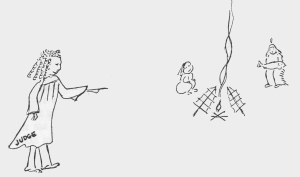 Finally, in 1931, in a case entitled Halbert v. United States, the Supreme Court declared that non-resident Chehalis, Cowlitz, and Chinook Indians were entitled to allotments on the Quinault Reservation. This decision to allow non-residents to receive allotments together with the ruling allotting timbered lands brought a rush of applications. During 1933 and 1934, 2340 trust allotments were granted and the reservation lands were exhausted, except for a very few acres.
Finally, in 1931, in a case entitled Halbert v. United States, the Supreme Court declared that non-resident Chehalis, Cowlitz, and Chinook Indians were entitled to allotments on the Quinault Reservation. This decision to allow non-residents to receive allotments together with the ruling allotting timbered lands brought a rush of applications. During 1933 and 1934, 2340 trust allotments were granted and the reservation lands were exhausted, except for a very few acres.
The Indian people who obtained allotments as a result of this Supreme Court ruling were called "Lawsuit Indians" and held in disregard by some of the reservation residents. It was felt that the "Lawsuit Indians" had taken land away from the Quinaults, even though the reservation had been enlarged so that all the "fish-eating" tribes could be collected on the reservation and they had every right to be there.
At this point, one must consider what had happened to the ancestral lands of the Chinook, Chehalis, and Cowlitz Indians. In the case of the Chinooks and Cowlitz, their lands had simply been taken over by the United States through Executive Proclamation stating that their lands were to become part of the public domain open to free homesteading and other devious acts to control property. In the case of the Cowlitz, 1,716,000 acres of land were taken which included parts of five counties (Pierce, Clark, Cowlitz, Skamania, and Lewis) and two-thirds of the Gifford Pinchot National Forest - all to this day without any compensation or treaty. The Chinook situation was very similar to that of the Cowlitz. The Chehalis did receive a very small reservation by Executive Order just east of the town of Oakville. No battles had been fought nor victories hailed. As a result of these infamous acts, the skeletons of the ancestral lands of these tribes continue to rattle in the closets in Washington, D.C.
It is ironical to note that although Governor Stevens had lost the battle at the Cosmopolis Council, his successors were finally winning the war. The governmental machine had finally placed all Indians on one reservation, even if in allotment ownership only. In the case of the Cowlitz, Chinook, and Chehalis, the application for an allotment was the last chance to grasp any form of Indian identity. It was, at that time, the last opportunity to grasp some compensation for past treatment and loss.
In 1934, a very important piece of legislation passed Congress. It was called the Wheeler-Howard Act or the Indian Reorganization Act. It was an act to conserve and develop Indian lands and resources; to extend to Indians the right to form business and other organizations; to establish a credit system for Indians; to grant certain rights of home rule to Indians; to provide for vocational education for Indians; and for other purposes.
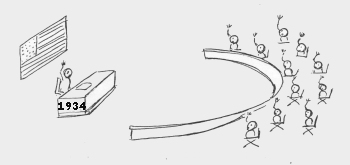 Whether or not the Quinault Reservation was to come under the provisions of this Act was put to a vote of the Allottees of the Reservation. The total voting population numbered 764. 184 people voted for the Act and 176 voted against it - and 404 people did not vote. It is interesting that the absentee voters (those people eligible to vote and not living on the Reservation) were responsible for its passage. Today, those people who were responsible for its passage are not allowed to benefit from it unless they are Quinault or Quileute tribal members.
Whether or not the Quinault Reservation was to come under the provisions of this Act was put to a vote of the Allottees of the Reservation. The total voting population numbered 764. 184 people voted for the Act and 176 voted against it - and 404 people did not vote. It is interesting that the absentee voters (those people eligible to vote and not living on the Reservation) were responsible for its passage. Today, those people who were responsible for its passage are not allowed to benefit from it unless they are Quinault or Quileute tribal members.
To this day, the Bureau of Indian Affairs uses the Wheeler-Howard Act to regulate acquisition of land in trust on the Reservation. The Bureau of Indian Affairs says to acquire land in trust a person must be: 1. A member of any recognized tribe now under federal jurisdiction, or 2. Descendants of such members who were, on June 1, 1934, residing within the present boundaries of any Indian reservation, or 3. One-half or more Indian blood. As a result, if you are an original allottee or heir and if you can't quality for any of the above categories, you will have trouble obtaining land in trust or changing feel land to trust land.
The Indian Reorganization Act is the federal system under which recognized Indian tribes operate. They are dependent upon the provisions of this act in order to receive the many benefits that are now open to them. When one looks at the act closely, termination of Indian tribes was the philosophy behind it. As Indian blood lines decrease due to intermarriage with other races, the requirements of an "IRA Indian" become hard and harder to meet. Within two generations, the Quinault tribe may have all but phased itself out of existence as far as meeting the requirements of the Act. What do you think will happen to our reservation if we don't iron out our differences and work together right now?
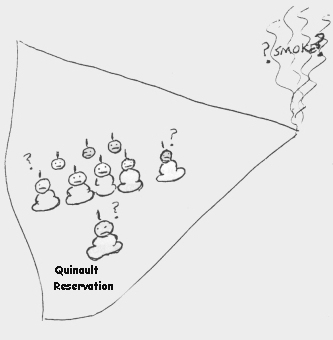 |
With the current trend in public attitude toward Indians - we must work together.
|
Without a doubt a great danger threatens the Quinault reservation as a result of BIA interpretation of the Wheeler-Howard Act. The problem lies in land passing from trust status to fee simple status (taxable). Here is how it happens:
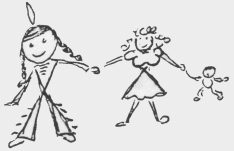 |
An Indian landowner (with land in trust) marries a white person and they have a child.
|
|
Suppose the Indian dies first without a will. The land is inherited one-half by the white spouse and one-half by the Indian child.
|
 |
 |
The white one-half goes out of trust into fee simple status and is no longer considered Indian land. The Indian child's one-half stays in trust.
|
In this manner, there are many people who own land one-half in trust and one-half in fee. In this manner, more and more land passes from Indian ownership all the time. You can sell fee simple land to the first person that comes along if you wan to - and many people do just that. This land will likely never be Indian land again.
Another important piece of litigation that has had an impact on the Quinault reservation was entitled "The Quinault Tribe of Indians v. The United States." The case involved a boundary dispute near Lake Quinault. Following is the opinion of the court resulting from that case:
"The treaty was entered into with both the Quinault and the Quileutes, and Article VI of it provided that these tribes might be consolidated with other friendly tribes or bands for the purpose of occupying and enjoying the Reservation; hence, when the Executive Order establishing the Reservation was issued, acting under the authority of Article VI, it set aside the Reservation not only for the Quinaults and Quileutes, but also for the Hohs, Quits, and other tribes of fish-eating Indians on the Pacific coast. And the Supreme Court held, in Halbert v. United States, 283 U.S. 753, that the Chehalis, Chinook, and Cowlitz tribes were entitled to equal rights in the Reservation because they came within the designation of fish-eating Indians on the Pacific coast.
It is plain, therefore, that the Quinaults are not entitled to exclusive rights in the Reservation. The Quileutes, Hohs, Quits, Chehalis, Chinook, and Cowlitz tribes are also entitled to an interest therein."
(Remember, these are not our words - but the words of a court of law.)
The history of the Quinault Reservation unfolds day by day. Many Indians from many different times and places have been involved in its making. At this point in time, it is imperative that all Indians involved in the Reservation band together for mutual benefit and protection of what little was left to them by the "Great Father" back in Washington, D.C. Personal conflicts must be overcome by the cooperation of all, if we are to move ahead in history with what we have.
|





 A treaty council was called by Governor Stevens, who was also superintendent of Indian Affairs of the Territory of Washington. The council was held on the banks of the Chehalis River near the present town of Cosmopolis. Stevens brought a treaty for the Indians to sign. It said that they would give up all title to almost all the coastal area of Washington. Stevens said that they would all be moved to a reservation that would be selected by the Great Father in Washington, D.C. The reservation was intended to be the Quinault Reservation as we know it today. This first treaty was never signed. As this story goes on, you will see why.
A treaty council was called by Governor Stevens, who was also superintendent of Indian Affairs of the Territory of Washington. The council was held on the banks of the Chehalis River near the present town of Cosmopolis. Stevens brought a treaty for the Indians to sign. It said that they would give up all title to almost all the coastal area of Washington. Stevens said that they would all be moved to a reservation that would be selected by the Great Father in Washington, D.C. The reservation was intended to be the Quinault Reservation as we know it today. This first treaty was never signed. As this story goes on, you will see why.
 The Chinook, Chehalis, and Cowlitz Indians did not want to go onto a reservation to the north on the coast. They wanted small reservations where they lived, in the lands of their ancestors.
The Chinook, Chehalis, and Cowlitz Indians did not want to go onto a reservation to the north on the coast. They wanted small reservations where they lived, in the lands of their ancestors.

 As time passed, settlers continued to pour in and homestead land that still belonged to the Indians who did not sign the treaty. The government still wanted to move all the other tribes to the treaty Quinault Reservation.
As time passed, settlers continued to pour in and homestead land that still belonged to the Indians who did not sign the treaty. The government still wanted to move all the other tribes to the treaty Quinault Reservation.
 Ten thousand acres was far too little for all the "fish-eating" tribes of western Washington. This term "fish-eating" was destined to play a key role in the expansion of the reservation at a later date.
Ten thousand acres was far too little for all the "fish-eating" tribes of western Washington. This term "fish-eating" was destined to play a key role in the expansion of the reservation at a later date.
 As a result of R.H. Milroy's recommendation, a much larger reservation was finally created on November 4, 1873, when an Executive Order by President U.S. Grant set aside the present day reservation which has been maintained to this day with the same boundaries, enclosing an area of about 200,000 acres. This new Quinault Reservation was created for all the "fish-eating" Indians of the Washington coast.
As a result of R.H. Milroy's recommendation, a much larger reservation was finally created on November 4, 1873, when an Executive Order by President U.S. Grant set aside the present day reservation which has been maintained to this day with the same boundaries, enclosing an area of about 200,000 acres. This new Quinault Reservation was created for all the "fish-eating" Indians of the Washington coast.
 In the course of time, and under the authority of the Executive Order, the residents and allotment holders of the Quinault Reservation came to include Indians of full or mixed ancestry from all tribes mentioned earlier, which is to say all tribes of coastal Washington and some from the interior, especially in the south.
In the course of time, and under the authority of the Executive Order, the residents and allotment holders of the Quinault Reservation came to include Indians of full or mixed ancestry from all tribes mentioned earlier, which is to say all tribes of coastal Washington and some from the interior, especially in the south.

 Finally, in 1931, in a case entitled Halbert v. United States, the Supreme Court declared that non-resident Chehalis, Cowlitz, and Chinook Indians were entitled to allotments on the Quinault Reservation. This decision to allow non-residents to receive allotments together with the ruling allotting timbered lands brought a rush of applications. During 1933 and 1934, 2340 trust allotments were granted and the reservation lands were exhausted, except for a very few acres.
Finally, in 1931, in a case entitled Halbert v. United States, the Supreme Court declared that non-resident Chehalis, Cowlitz, and Chinook Indians were entitled to allotments on the Quinault Reservation. This decision to allow non-residents to receive allotments together with the ruling allotting timbered lands brought a rush of applications. During 1933 and 1934, 2340 trust allotments were granted and the reservation lands were exhausted, except for a very few acres.
 Whether or not the Quinault Reservation was to come under the provisions of this Act was put to a vote of the Allottees of the Reservation. The total voting population numbered 764. 184 people voted for the Act and 176 voted against it - and 404 people did not vote. It is interesting that the absentee voters (those people eligible to vote and not living on the Reservation) were responsible for its passage. Today, those people who were responsible for its passage are not allowed to benefit from it unless they are Quinault or Quileute tribal members.
Whether or not the Quinault Reservation was to come under the provisions of this Act was put to a vote of the Allottees of the Reservation. The total voting population numbered 764. 184 people voted for the Act and 176 voted against it - and 404 people did not vote. It is interesting that the absentee voters (those people eligible to vote and not living on the Reservation) were responsible for its passage. Today, those people who were responsible for its passage are not allowed to benefit from it unless they are Quinault or Quileute tribal members.